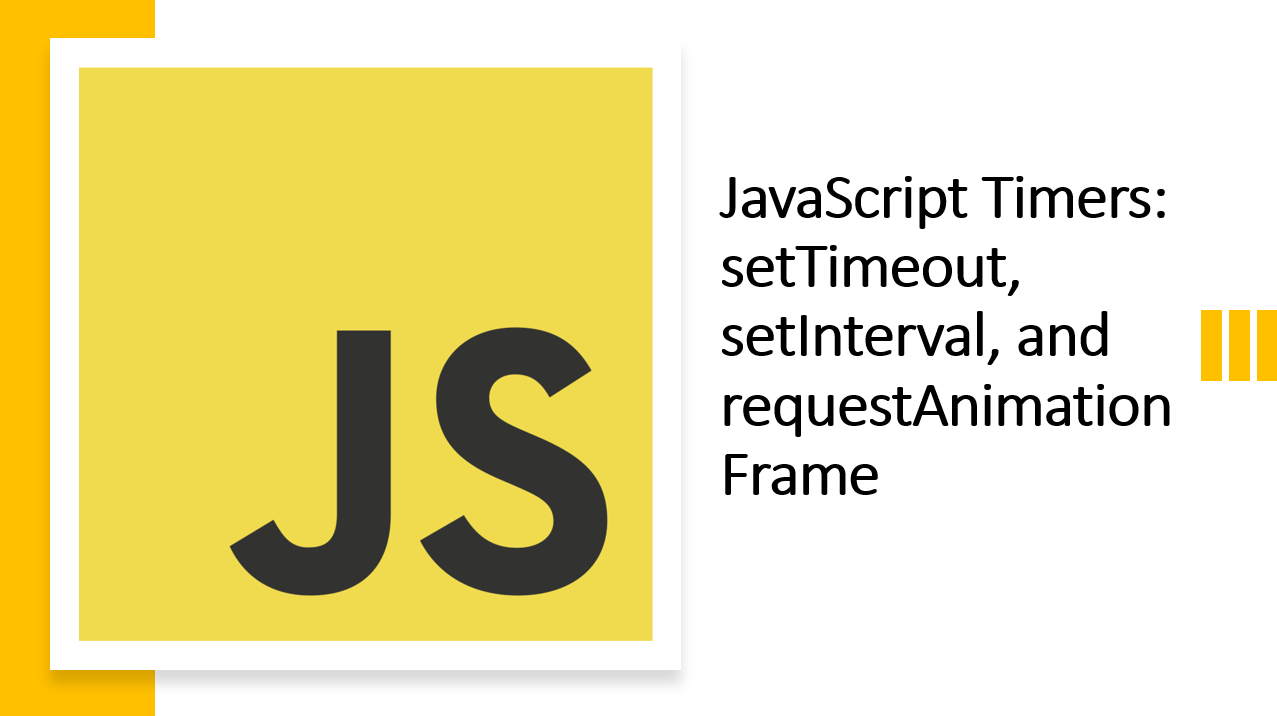
Introduction
In JavaScript, timers are essential for scheduling and managing tasks that occur asynchronously. These timers allow you to control when functions or code snippets should run. Three commonly used timers are setTimeout, setInterval, and requestAnimationFrame.
In this guide, we'll explore each timer's purpose, usage, and how they differ from one another.
Let's dive in! 🏊♀️
1. The setTimeout
The setTimeout method is used to schedule a function or code snippet to run after a specified amount of time. It accepts two arguments: a callback function and a delay in milliseconds.
For example:
const timeoutId = setTimeout(() => {
console.log("Timeout!");
}, 1000); // After 1 second
// To stop the timeout on function call
const stopTimeout=(timeoutId)=>{
clearTimeout(timeoutId);
}
In the example above:
- The
setTimeoutmethod is used to schedule a function to run after 1000 milliseconds (1 second). - The callback function passed to
setTimeoutwill be executed after 1000 milliseconds (1 second). - The
setTimeoutmethod returns a timeout ID that can be used to stop the timeout using theclearTimeoutmethod. - The
clearTimeoutmethod is used to stop the timeout after 5000 milliseconds (5 seconds).
2. The setInterval
The setInterval method is used to schedule a function or code snippet to run repeatedly after a specified amount of time. It accepts two arguments: a callback function and a delay in milliseconds.
For example:
let count = 0;
const intervalId = setInterval(() => {
console.log("Interval count:", count++);
}, 1000); // Every 1 second
// To stop the interval after 5 seconds
setTimeout(() => {
clearInterval(intervalId);
}, 5000);
In the example above:
- The
setIntervalmethod is used to schedule a function to run every 1000 milliseconds (1 second). - The callback function passed to
setIntervalwill be executed every 1000 milliseconds (1 second). - The
setIntervalmethod returns an interval ID that can be used to stop the interval using theclearIntervalmethod. - The
clearIntervalmethod is used to stop the interval after 5000 milliseconds (5 seconds).
3. The requestAnimationFrame
requestAnimationFrame is designed for smoother animations and rendering, taking the browser's optimization into account.
For example:
function animate(timestamp) {
// Animation logic here
requestAnimationFrame(animate);
}
requestAnimationFrame(animate);
In the example above:
- The
requestAnimationFramemethod is used to schedule a function to run before the next repaint. - The callback function passed to
requestAnimationFramewill be executed before the next repaint.
Usage Differences
setTimeout:Used for delaying a single function execution.setInterval:Used for executing a function repeatedly at fixed intervals.requestAnimationFrame:Used for smoother animations and rendering, respecting browser optimizations.
Advantage and Best Practices
- Use
setTimeoutwhen you want to delay a specific action. - Prefer
setIntervalwhen you need to perform a task at fixed intervals. - Use
requestAnimationFramefor animations, as it synchronizes with the browser's rendering.
Considerations
- Be cautious with
setInterval, as if tasks take longer than the interval, they can overlap, causing performance issues. requestAnimationFrameis generally recommended for animations due to its efficient use of browser resources.
Conclusion
JavaScript timers, namely setTimeout, setInterval, and requestAnimationFrame, provide essential tools for managing asynchronous tasks and animations. Depending on your use case, you can effectively schedule actions or create smooth animations using these timers. By understanding their purposes and differences, you'll have the tools you need to build responsive and interactive web applications.
We hope you found this guide helpful!
Happy coding! 🚀